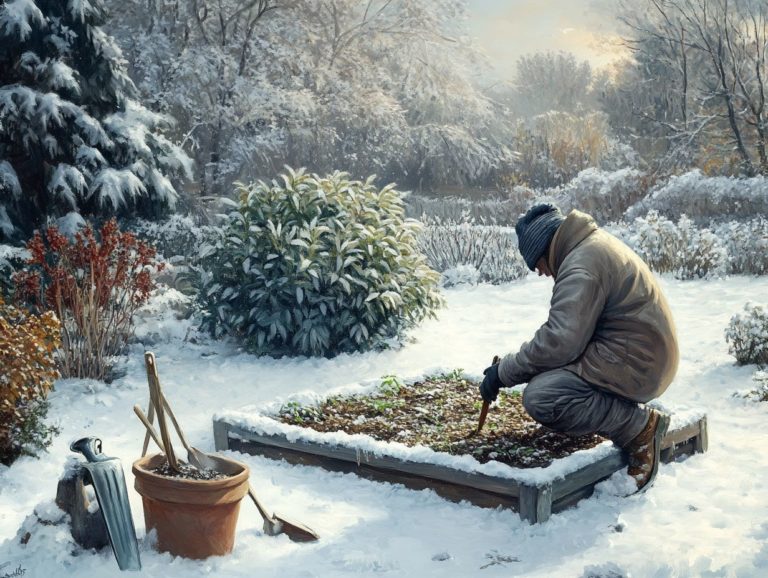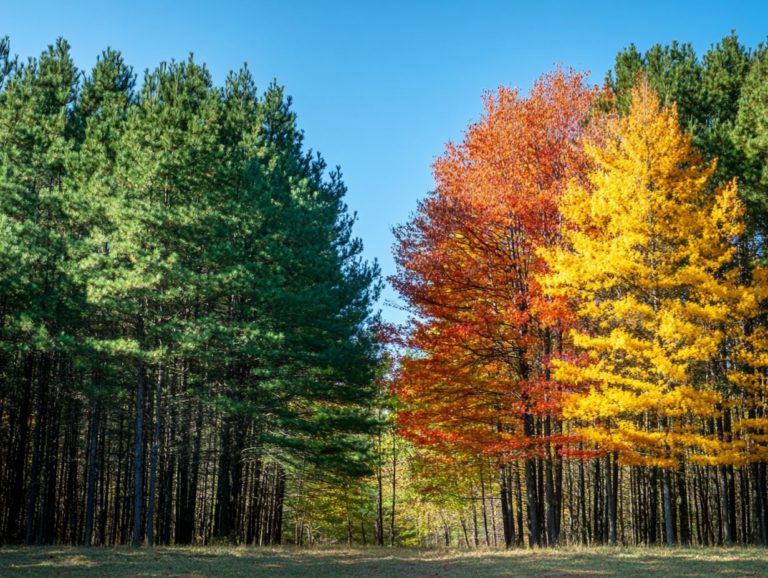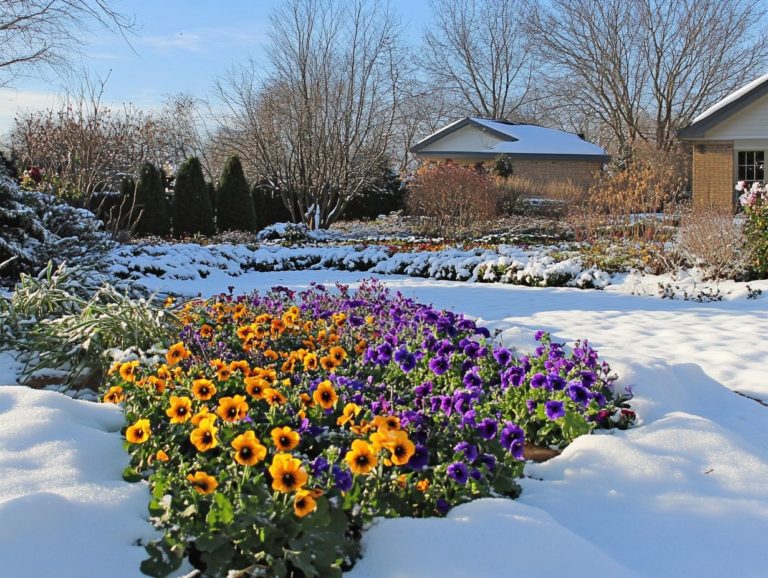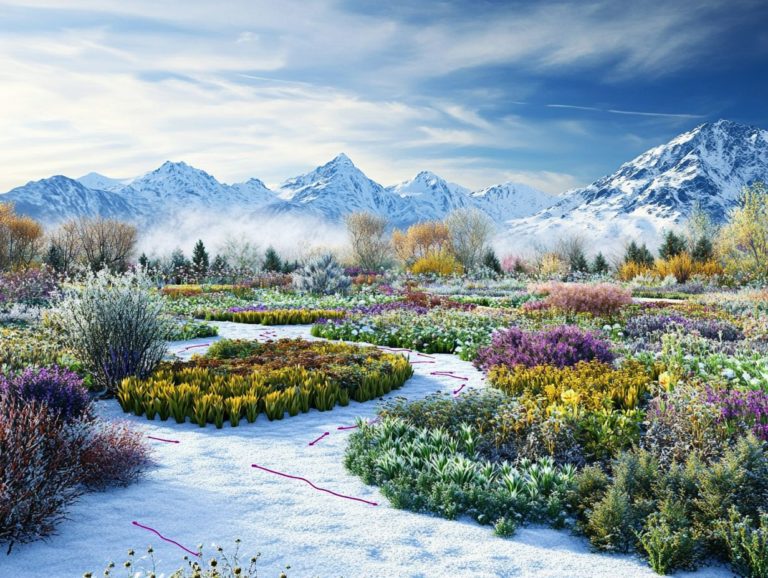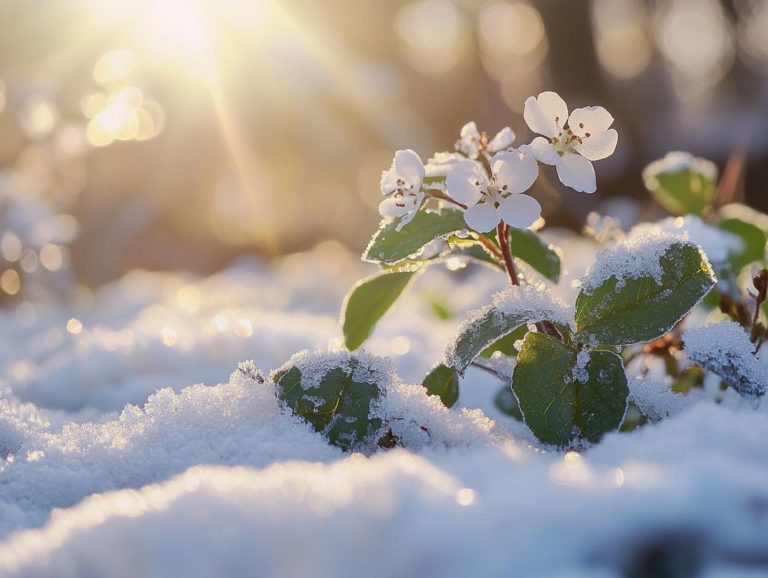Native Cold-Climate Grasses You Should Try
If you re looking to improve your yard while embracing nature’s resilience, native cold-climate grasses present an exceptional choice.
This article delves into 15 remarkable varieties, ranging from the graceful Blue Wildrye to the robust Big Bluestem. Discover why these stunning native grasses are the perfect choice for your yard! You ll learn their maintenance requirements and how to seamlessly integrate them into your existing landscape.
We will clarify common misconceptions to help you make informed decisions. Immerse yourself in this journey to transform your outdoor space with these stunning native options!
Contents
- Key Takeaways:
- 1. Blue Wildrye
- 2. Purple Needlegrass
- 3. Slender Wheatgrass
- 4. Little Bluestem
- 5. Canada Wildrye
- 6. Arctic Bluegrass
- 7. Idaho Fescue
- 8. Western Wheatgrass
- 9. Big Bluestem
- 10. Prairie Junegrass
- 11. Crested Wheatgrass
- 12. Sandberg Bluegrass
- 13. Bottlebrush Squirreltail
- 14. Indian Ricegrass
- 15. Green Needlegrass
- What Makes These Native Grasses Suitable for Cold Climates?
- Frequently Asked Questions
Key Takeaways:
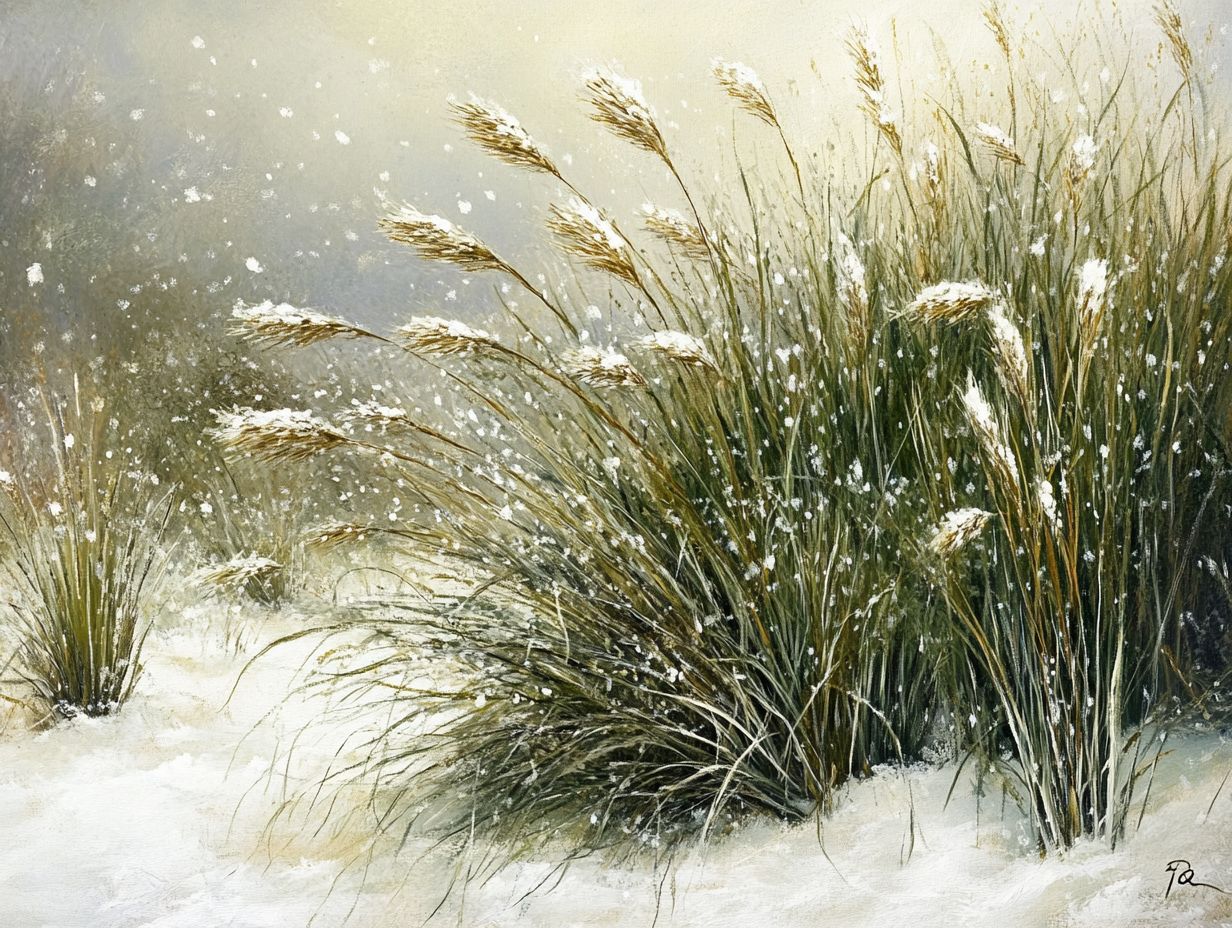
- Native cold-climate grasses like Blue Wildrye and Purple Needlegrass are not only beautiful but also highly adaptable to harsh winter conditions, showcasing their easy-to-maintain characteristics.
- These grasses bring numerous benefits to your lawn or landscape, including erosion control, wildlife habitat, and low maintenance requirements.
- Don’t be afraid to incorporate these grasses into your existing landscape they can add texture and interest to any design.
1. Blue Wildrye
Blue Wildrye (Elymus glaucus) is a standout native grass that thrives in cold climates. You’ll appreciate its wildlife-friendly qualities and low maintenance needs, making it an ideal option for sustainable landscaping.
It particularly excels in full sun and medium moisture conditions. This perennial grass not only provides habitat and nourishment for birds and various insects, but its dense root system is also crucial for water conservation.
By drawing moisture deep into the soil, it helps prevent erosion and promotes healthy ecosystems. Its ability to adapt to different soil types whether clay or sandy means it can flourish in a variety of environments.
These traits make it a valuable component of both natural and cultivated landscapes. Blue Wildrye is a great choice for gardeners eager to enhance biodiversity and create a resilient environment.
2. Purple Needlegrass
Purple Needlegrass (Stipa pulchra) is a remarkable ornamental native grass that enhances your landscape while maintaining healthy ecosystems by providing essential food resources for local wildlife.
This elegant grass brings a soft, flowing texture to your garden, capturing the essence of natural beauty and elevating the visual appeal of your outdoor space. By incorporating Purple Needlegrass into your landscaping designs, you can effectively minimize the area dedicated to traditional turf lawns.
Traditional lawns often demand excessive water and maintenance. This thoughtful choice contributes to cultivating sustainable gardens that benefit the environment.
Furthermore, it supports a diverse range of wildlife, including Elk and Pronghorn. This creates habitats that nurture healthy populations and enrich the overall garden ecosystem.
In doing so, you enhance biodiversity and promote ecological balance, making your garden not just a beautiful space but a thriving ecosystem.
3. Slender Wheatgrass
Slender Wheatgrass (Elymus trachycaulus) flourishes in a variety of climates and soil types. It’s celebrated for its wildlife-friendly attributes and its valuable role in capturing carbon from the atmosphere.
Its impressive adaptability allows this grass to thrive in both arid and moist environments, making it essential to diverse ecosystems. This resilience supports countless local species, from tiny insects to larger herbivores.
By capturing carbon dioxide from the air, this grass serves as a natural climate solution, helping to mitigate greenhouse gas emissions. Through these vital processes, it fosters robust and sustainable ecosystems that benefit numerous species.
This demonstrates its integral role in maintaining ecological balance and promoting environmental health.
Don t wait! Transform your outdoor space today with these beautiful grasses that are easy to care for!
4. Little Bluestem
Little Bluestem (Schizachyrium scoparium) is a stunning native grass that thrives in full sun and medium moisture conditions. It effortlessly showcases its ornamental value while providing a sanctuary for local wildlife.
This resilient grass has striking blue-green foliage that transforms into breathtaking coppery shades in the fall. It flourishes in well-drained soils, making it a superb choice for diverse landscape designs. You ll appreciate its ability to survive with little water, which enhances its appeal as a low-maintenance option for your garden.
Little Bluestem serves as a vital habitat for various birds and beneficial insects, including pollinators. It plays a crucial role in boosting biodiversity within garden ecosystems.
By cultivating this vibrant grass today, you enhance the beauty of your outdoor spaces while supporting local wildlife, providing valuable shelter and nesting opportunities.
5. Canada Wildrye
Canada Wildrye (Elymus canadensis) is your go-to native grass that requires minimal maintenance while excelling in water conservation. It s a must-have for anyone serious about sustainable landscaping across various climates.
This remarkable grass thrives in a diverse range of soil types, from sandy to clay-rich environments. It plays a crucial role in preventing soil erosion. With its deep root systems, Canada Wildrye retains moisture in the ground, fostering healthier ecosystems, particularly in areas susceptible to drought.
Its lush foliage looks great and attracts a variety of wildlife. This creates a thriving habitat for pollinators and other beneficial species. These advantages make it a perfect addition to eco-friendly gardening, enhancing biodiversity and promoting environmental sustainability.
6. Arctic Bluegrass
Arctic Bluegrass (Poa arctica) is your go-to low-maintenance native grass, perfectly suited for those challenging climates. It not only enhances the health of ecosystems but also provides vital shelter and nesting opportunities for a variety of wildlife species.
This resilient grass thrives in frigid temperatures and requires minimal watering and care, making it an ideal choice for sustainable landscaping. Its robust root system stabilizes the soil, effectively preventing erosion and promoting biodiversity.
In its role as a habitat, Arctic Bluegrass is essential for supporting local bird populations and beneficial insects, offering them protection against extreme weather conditions.
As these species find refuge among its blades, they contribute to the overall ecological balance, enriching the environment and creating a vibrant tapestry of life in areas that might otherwise seem inhospitable.
7. Idaho Fescue
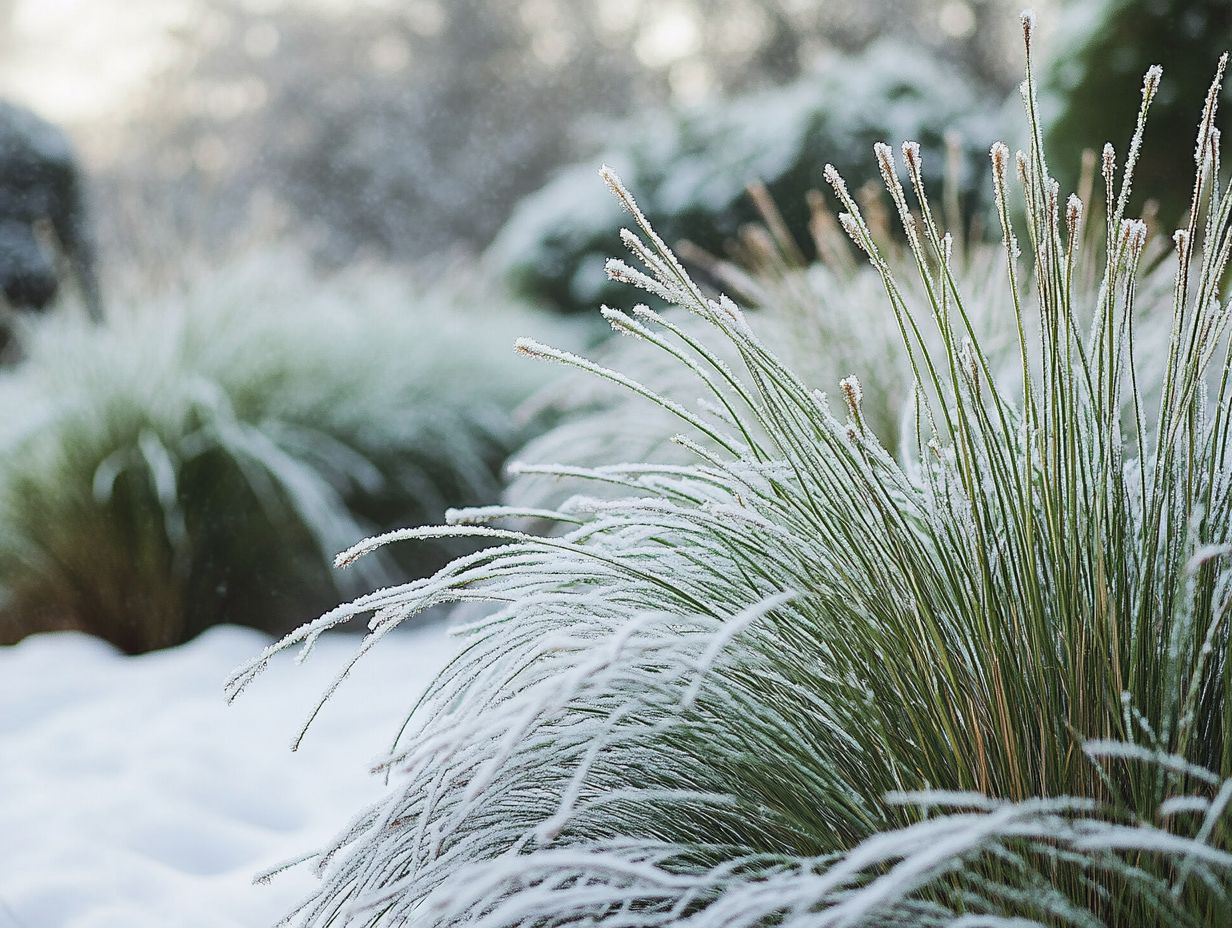
Idaho Fescue (Festuca idahoensis) is an ornamental native grass celebrated for its deep root systems, making it an exceptional choice for your landscaping projects. Not only does it promote soil health, but it also supports local wildlife.
The robust root structure of Idaho Fescue plays a vital role in preventing soil erosion. It stabilizes the ground in both gardens and meadows. Its graceful tufts and vibrant green color enhance the aesthetic appeal of your landscape, creating a serene, natural setting that invites tranquility.
Beyond its visual charm, this grass becomes a sanctuary for local wildlife, providing essential habitats for insects and small animals. By incorporating Idaho Fescue into your gardens, you contribute to a more sustainable environment, enriching biodiversity while reveling in the beauty and resilience of this remarkable native plant.
Start your garden transformation with Idaho Fescue today!
8. Western Wheatgrass
Western Wheatgrass (Pascopyrum smithii) is a resilient native grass that thrives in various conditions. It plays a pivotal role in supporting wildlife and adapting to the challenges of climate change.
This hardy species exhibits remarkable adaptability. It flourishes in diverse soil types and climatic conditions, stabilizing ecosystems across the Western United States.
By providing essential habitat and food for many species, including birds and small mammals, it helps keep our ecosystems diverse.
Its robust root system captures and stores carbon dioxide effectively, improving soil health and reducing erosion.
As you prioritize sustainable practices in land management, the importance of Western Wheatgrass becomes clear. It enhances agricultural resilience and supports ecological balance.
9. Big Bluestem
Big Bluestem (Andropogon gerardii) stands tall as a native grass, offering excellent shelter and nesting opportunities for various wildlife species. It’s a breeze for gardeners!
This remarkable grass thrives in a wide range of soil types. It can reach heights of up to 10 feet, creating a lush habitat that supports birds and welcomes beneficial insects and small mammals.
Its deep root system retains soil moisture and enhances soil health. This makes it a sustainable alternative to traditional turf lawns.
Plant Big Bluestem in your yard! You’ll create a vibrant ecosystem that attracts pollinators and requires less maintenance.
10. Prairie Junegrass
Prairie Junegrass (Koeleria macrantha) stands out as a low-maintenance native grass. It significantly contributes to capturing and storing carbon while supporting thriving ecosystems in grassland environments.
This resilient perennial adapts effortlessly to various soil types, flourishing in everything from sandy to clay-rich substrates. It’s an ideal choice for your land restoration projects.
By capturing carbon dioxide from the atmosphere and storing it in the soil, this grass plays a crucial role in addressing climate change.
Its robust root system enhances soil health and stability. The grass itself serves as vital habitat for various wildlife species, promoting biodiversity within its native range.
11. Crested Wheatgrass
Crested Wheatgrass (Agropyron cristatum) is a robust native grass that excels in water conservation. It s a premier choice for crafting wildlife-friendly landscapes across diverse climates.
This resilient species thrives in challenging soil conditions, showcasing impressive adaptability. It stabilizes the soil and enhances its structure, fostering a healthier ecosystem.
The grass serves as an essential source of cover and nourishment. This grass attracts various species, creating vital habitats.
Furthermore, Crested Wheatgrass s water-conserving abilities support the surrounding flora. This promotes a more sustainable environment that nurtures biodiversity, sustaining the intricate web of life within its ecosystem.
12. Sandberg Bluegrass
Sandberg Bluegrass (Poa secunda) emerges as a remarkable drought-tolerant native grass that thrives under medium moisture conditions. This versatility makes it invaluable in the fight against climate change and in fostering sustainable landscapes.
This grass is instrumental in supporting robust ecosystems. It provides essential cover for wildlife while improving soil structure, enhancing water retention and reducing erosion.
Its ability to flourish across a spectrum of moisture levels stabilizes soils effectively, whether in arid plains or more temperate settings.
As a native species, Sandberg Bluegrass encourages biodiversity. It creates a harmonious balance within plant communities and nurtures relationships between flora and fauna.
Incorporating this grass into landscape designs allows ecologists and land managers to cultivate resilience against environmental stressors. This ensures both plant and animal life can thrive despite shifting climatic conditions.
13. Bottlebrush Squirreltail
Bottlebrush Squirreltail (Elymus elymoides) is a low-maintenance native grass that stands out for its unique appearance. It plays a remarkable role in capturing and storing carbon dioxide, helping to combat climate change.
Thriving in a range of growing conditions, this resilient grass flourishes in well-drained soils. It effortlessly adapts to both dry and moderately moist environments, making it an exceptional choice for anyone seeking to cultivate a sustainable garden.
Its distinctive flower spikes, reminiscent of bottlebrushes, not only add a touch of beauty to your landscape but also attract pollinators, enriching the biodiversity of your garden.
As a carbon-sequestering species, it plays a vital role in combating greenhouse gases, ultimately enhancing the overall health and resilience of garden ecosystems. Integrating this hardy grass into your garden will create a beautiful space that benefits the environment.
14. Indian Ricegrass

Indian Ricegrass (Achnatherum hymenoides) is an amazing native grass that offers incredible benefits with its deep root systems. These roots enhance soil stability and provide essential habitat for wildlife, promoting biodiversity in your garden.
This resilient species thrives in a variety of soil types and conditions, making it an incredibly adaptable choice for landscaping in arid regions. Its lush green blades not only elevate the visual appeal of your natural spaces but also act as a vital food source for local herbivores.
Birds and small mammals find refuge among its dense growth, fostering a supportive ecosystem right in your backyard. By attracting beneficial insects and pollinators, Indian Ricegrass plays a crucial role in sustaining the health of surrounding plant communities, emphasizing its invaluable ecological significance.
Embrace this plant in your landscape; it’s not just a choice but a commitment to nurturing the environment.
15. Green Needlegrass
Green Needlegrass (Stipa viridula) is a native grass that requires minimal maintenance while enhancing your landscape and providing essential habitats for wildlife across varied environments.
This hardy grass flourishes in well-drained soils and adapts to a range of climatic conditions, making it a stellar choice for both gardeners and landscapers. Its fine, arching blades offer a soft, graceful texture to your garden designs, creating inviting spaces for pollinators and small creatures alike.
As a drought-tolerant species, it needs very little water once established, promoting sustainability in your landscaping efforts. By incorporating this grass into your local gardens, you not only support biodiversity but also provide food and shelter for birds and insects, which are crucial for maintaining ecological balance.
What Makes These Native Grasses Suitable for Cold Climates?
Native grasses are perfectly attuned to cold climates, thanks to their adaptive features and resilience against harsh weather. They re not just beautiful; they also create wildlife-friendly habitats, making them crucial in the fight against climate change.
These grasses typically boast deep root systems, allowing them to tap into moisture and nutrients hidden beneath frosty surfaces. This ensures their survival during droughts or extreme cold.
They re incredibly low-maintenance, needing little more than the occasional trim and minimal watering, which makes them a fantastic choice for both homeowners and landscapers.
Beyond their practical benefits, these grasses play a vital role in supporting local ecosystems. They offer food and shelter for various species, enhancing biodiversity while helping to stabilize soils and prevent erosion.
As climate challenges intensify, the adaptability of native grasses positions them to thrive, effectively reducing the impact of weather extremes on the environment. Embrace native grasses today, and make a real difference in your garden and our environment!
How Can These Grasses Benefit Your Lawn or Landscape?
Incorporating native grasses into your lawn or landscape offers numerous advantages. These include water conservation, reduced maintenance efforts, and features that attract local wildlife.
These grass varieties thrive in your local climate and soil, requiring minimal intervention. By opting for native selections, you save valuable time on upkeep while nurturing ecosystems that support pollinators and other beneficial species.
The unique textures and vibrant colors of these grasses add natural beauty to your surroundings, creating a tranquil backdrop for your gardens and outdoor spaces. This thoughtful decision fosters biodiversity, ensuring your landscape flourishes and boosting the ecological health of the area.
What Are the Maintenance Requirements for These Grasses?
Native grasses are an exceptional choice for your landscape as they are generally low maintenance and thrive with minimal care while offering significant ecological benefits.
Once established, these resilient plants require less watering, making them ideal for drought-prone areas. You may need to mow them periodically to keep their growth in check, but this task is usually minimal often requiring just a couple of sessions each year.
Pest management is simple, too. Native grasses have evolved alongside local insects and diseases, creating a balanced ecosystem. This adaptability reduces the need for chemical treatments and enhances biodiversity. By choosing native grasses, you embrace a sustainable gardening practice that works in harmony with nature.
How Can You Incorporate These Grasses into Your Existing Landscape?
Incorporating native grasses into your landscape is a straightforward yet effective way to enhance your garden ecosystems and create attractive designs that draw in wildlife.
These resilient plants not only complement various design aesthetics whether you prefer modern minimalism or rustic charm but also provide practical benefits like soil stabilization, which helps prevent erosion, and increased biodiversity.
As you plan your planting schemes, consider grouping native grasses with other compatible plants to create visually captivating layers. Their remarkable adaptability enables them to thrive in various soil types and moisture levels, making them a perfect fit for nearly any garden setting.
Regular maintenance, such as occasional pruning and controlled burns, may be necessary to ensure they flourish and blend seamlessly into your landscape.
What Are the Common Misconceptions About Native Cold-Climate Grasses?
Despite their advantages, misconceptions about native cold-climate grasses exist, particularly regarding their maintenance requirements and suitability for wildlife habitats. These misunderstandings may deter potential gardeners from embracing these remarkable plants.
Many believe native grasses require more effort than traditional lawns. However, once established, they are generally low maintenance and need less frequent mowing and watering. By choosing native grasses, you enhance your garden and provide essential habitats for various wildlife species, including pollinators and other beneficial organisms. This choice plays a vital role in promoting ecological balance and biodiversity.
Don’t overlook how native grasses combat climate change. Their deep root systems improve soil health, reduce erosion, and effectively sequester carbon. Recognizing these benefits can motivate you to integrate these resilient plants into your gardening repertoire, making a positive impact on the environment.
Frequently Asked Questions
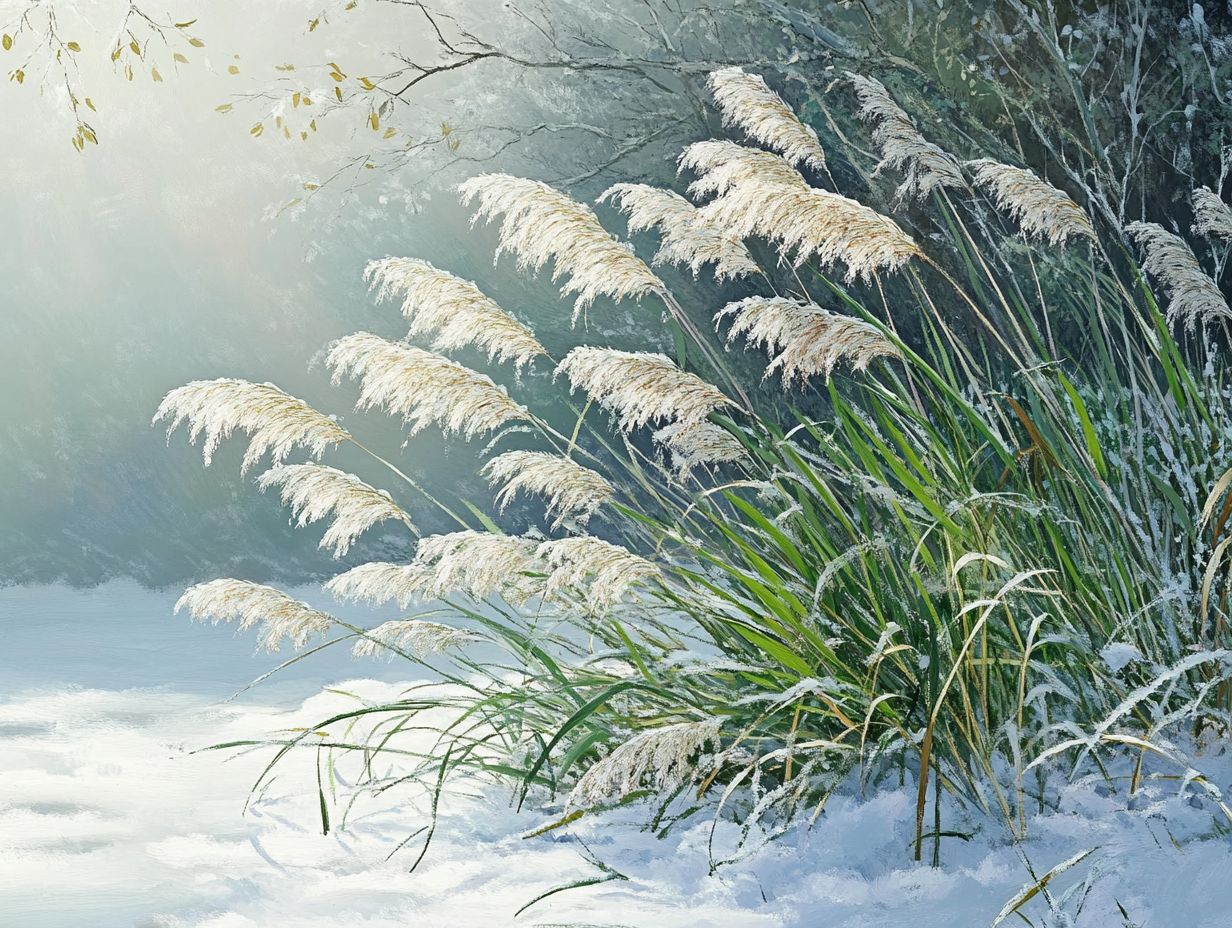
What are native cold-climate grasses?
Native cold-climate grasses are indigenous grasses that thrive in specific regions with colder climates. They are typically hardy, low maintenance, and beneficial to the local ecosystem.
Why Should I Try Native Cold-Climate Grasses?
Native cold-climate grasses thrive in our local environment. They need less water and maintenance than non-native species!
Which Native Cold-Climate Grasses Should I Try?
Consider blue grama, prairie dropseed, switchgrass, and little bluestem. These grasses are hardy and offer stunning fall colors!
How Do I Care for Native Cold-Climate Grasses?
Once established, these grasses require minimal care. Plant them in well-drained soil and avoid overwatering.
Pruning in spring can help promote healthy growth.
Can I Mix Native and Non-Native Species?
You can mix native cold-climate grasses with other species in your garden. Just choose plants with similar growing needs and steer clear of invasive species.
Where Can I Buy Native Cold-Climate Grasses?
Check your local nurseries and garden centers for native cold-climate grasses. You can also look for native plant sales or ask your local conservation district for recommendations!

